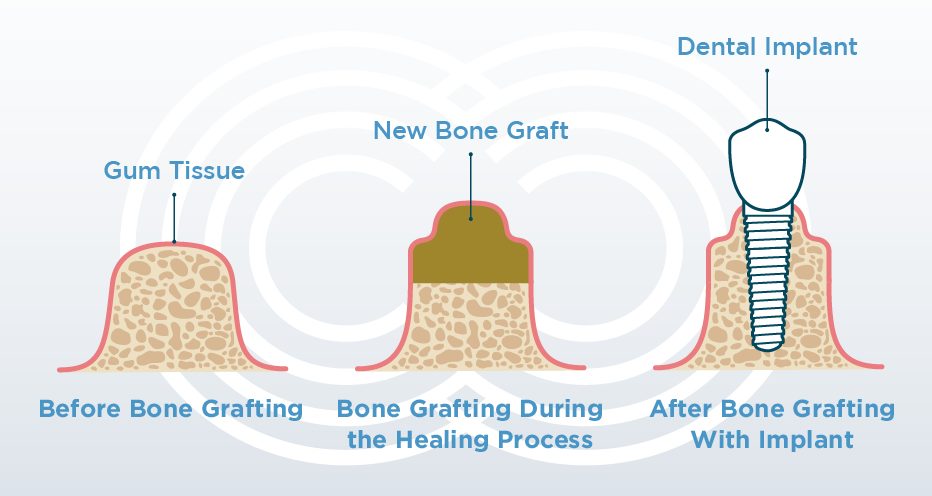Bone Grafting : Can You Have Dental Implants With Bone Loss?
By: Dr. Rajan Sharma

Can you have Dental Implants with Bone Loss ?
Most people who have dental implant treatment have strong enough jawbone to support them. However, can you have dental implants with bone loss? In some cases, enough bone loss has occurred that bone grafting is needed before an implant can be attached. After viewing a dental CT scan of your mouth, an implant dentist will be able to identify the best course of action and see if you are a candidate for dental implants. Continue reading to learn more about bone grafting for dental implants.
When is Bone Grafting Needed ?
If you have severe gum disease known as periodontitis, you may have lost some of the bone that holds teeth in place. Your dentist or a gum disease specialist (periodontist) may suggest a bone graft. Bone grafting stimulates new bone to replace the bone that was destroyed by periodontitis.
When you come in for a free consultation, an implant dentist will inform you of your treatment options based on your individual CT scan. They’ll let you know if you need bone grafting prior to dental implant placement.
What Causes Bone Loss ?
Bone loss may occur if you lose a tooth and do not replace it. It is also caused by gum disease. Gum disease is often caused by a prolonged lack of dental hygiene. Gingivitis is a mild form of this disease. Go through this to know can you have dental implants with bone loss.
When gum disease is left untreated it can develop into a more severe form called periodontitis. At this stage, the bacteria that has infected the tooth and gums has also affected the underlying jaw bone. An early sign of gum disease is bleeding and swollen gums. Symptoms of the progression to periodontitis is persistent bad breath, loose teeth, and mouth pain when chewing. At this stage, a periodontist should be consulted.
If the disease has resulted in bone loss, this makes attaching a dental implant more difficult. A dental implant features small metal rods that are fused to the jaw bone. An abutment is attached to these rods and the artificial tooth or crown is attached. The absence of strong bone material is a problem but a bone graft makes the procedure possible.
How is Bone Grafting Done for Dental Implants ?
Periodontists use different sources for bone grafts. The bone often comes from either the patient or a donor. They can also be made from synthetic materials.
To prepare for the procedure, the periodontal surgeon will clean out the infected gums and surfaces of the tooth and apply the graft which will help strengthen the bone. The new bone material will eventually be replaced by new bone growth. It will take several months before the bone is ready. Depending on the success of the graft, the bone may be strong enough to support the dental implant.
Of course, gum disease and the need for a bone graft can be prevented with proper dental care, which includes brushing twice a day, flossing every day, and visiting your dentist every six months for cleanings and checkups.
Types of Bone Grafts
Grafting material can come from a variety of sources, from harvesting your own bone to an animal or cadaver bone. The material can also be synthetic and come in a variety of forms: gels, powders, granules, and putty. Check out the types of bone grafts for dental implants.
- Autograft: takes bone from one site in your body and moves it to another. This is the only type of bone graft that involves creating two surgical sites, the one from which the bone is taken and the one where it is deposited.
- Allograft: laboratory-processed human bone from a deceased donor that comes from a tissue bank.
- Xenograft: comes from an animal, typically a cow
- Alloplast: This type of graft uses synthetic materials
How Long Does Bone Graft Healing Take ?
After your bone grafting for dental implants has been placed you may experience some discomfort at the surgical site. Over-the-counter medications for inflammation should ease your discomfort. Just know that it may take 6 months for your bone to be completely developed and to receive your dental implant.
The waiting period ensures the best desired results so you can have a healthy, happy smile for a lifetime.
Schedule Your Free Consultation & CT Scan
Should a bone graft be necessary, you’ll be in good hands with the highly-trained dental professionals at EON Clinics. We are dedicated to your oral health and well-being. We work with highly-trained doctors and dental assistants who use cutting-edge technology in our in-house labs. This creates a one-stop shop for all dental implant needs at clinics throughout Chicagoland and in southern Wisconsin and northwest Indiana.
Find out how a bone grafting for dental implants can improve your life. Schedule a free consultation online today or call us at 800-250-3500.
